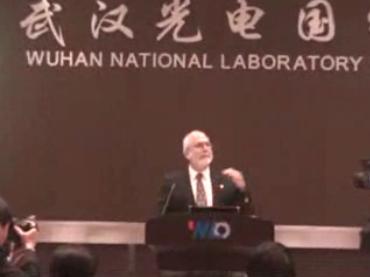Title: Biophotonics Focused on Grand Challenges in Medicine and Bioscience
Speaker: Pro. Dennis L. Matthews
Time: Oct.28. 2008. 7:00 P.M.
Venue: Room A101 At WNLO
Abstract:
Biophotonics, the application of photon-based technologies and methods to bioscience and medicine, is becoming an increasingly important means of diagnosing and treating disease as well as studying the underlying mechanisms which govern how living organisms function. There is also now a large community of researchers around the globe who are actively creating and applying biophotonics tools and methods. Industry is also a major player in the field of biophotonics since it represents a ~$50B/yr global market sector and there is a constant need to develop, manufacture and distribute biomedical and scientific instrumentation.
Despite these efforts there are many areas in bioscience and medicine that can benefit from a concerted and global interdisciplinary effort in both research and translation of biophotonics devices, software, fluorescent probes and methods. Some examples of the challenges include the development of portable and ruggedized point-of-care technologies for diagnosing and treating patients in remote areas or even metropolitan regions in the aftermath of a pandemic event. Non-invasive biophotonic devices are well suited to and would be especially valuable for these applications. New methods of imaging that do not rely on large instrumentation or ionizing radiation are needed for providing critical diagnoses for stroke and traumatic brain injury victims. Of course, there also needs for of early cancer diagnosis from analyzing blood samples and, of most importance, a means of treating metastatic disease through molecular-based targeting of cancer cells. Treatment of infections using photodynamic therapy can also be explored as a means to avoid use of antibiotics. Many other major challenges arise in bioscience and medicine including characterization and distillation of stem cells, identification and destruction of cancer stem cells, image guidance of ultra-precision surgery, to name but a few opportunities for the application of biophotonics tools and methods.
In my presentation, I will review some highlights for the field of biophotonics and then talk about new opportunities for research as well as medical and scientific device development. I will also describe a new “Biophotonics for Life Consortium” we in the community are forming and how it can provide a coordinated global effort to meet some of the grand challenges that continue to exist in medicine and bioscience.
Biography:
Dr. Matthews is Principal Investigator and Director of the National Science Foundation’s Center for Biophotonics Science and Technology. Dr. Matthews is also the Associate Director and Biomedical Technology Program Leader for the UC Davis Cancer Center that received NCI designation in 2002. Dr. Matthews is also responsible for the development of industrial and medical applications of Lawrence Livermore National Lab Technology, especially for the prevention, screening, diagnosis and treatment of diseases such as diabetes, stroke, brain trauma, chronic pain and cardiovascular disease. Dr. Matthews leads a multi-directorate Center within Livermore whose mission is to develop medical devices in collaboration with industry. Current projects and those already successfully transferred to industry include: an opto-acoustic recanalization device for treating ischemic stroke; a miniature x-ray source which is mounted on a microcatheter and used to treat coronary artery restenosis; micropower impulse radar for numerous medical diagnostics including differentiating hemorrhagic vs. ischemic stroke; an implantable, continuous glucose monitor; a compact proton accelerator for radiation therapy; as well as ultra-short-pulse duration laser microsurgery devices.
He received his Ph.D. in Physics in 1974 from the University of Texas at Austin. His thesis work dealt with the understanding the radiative and collisional ionization properties of energetic heavy ions moving through gases and solids. Dr. Matthews is an expert on the radiative properties of ions in plasmas as well as in the conversion of laser light into x-rays. Dr. Matthews is also an expert in developing optically based biosensors and medical devices.
Dr. Matthews has written well over 200 publications in the scientific literature and holds numerous patents, especially for medical devices and commercial applications of lasers. He is a fellow of the American Physical Society and the Optical Society of America and is a co-recipient of the 1990 Division of Plasma Physics Award for Excellence in Plasma Physics Research. He is also a member of the American Physical Society, Optical Society of America, the Society of Photographical and Industrial Engineers and the Institute for Electrical and Electronics Engineers.
